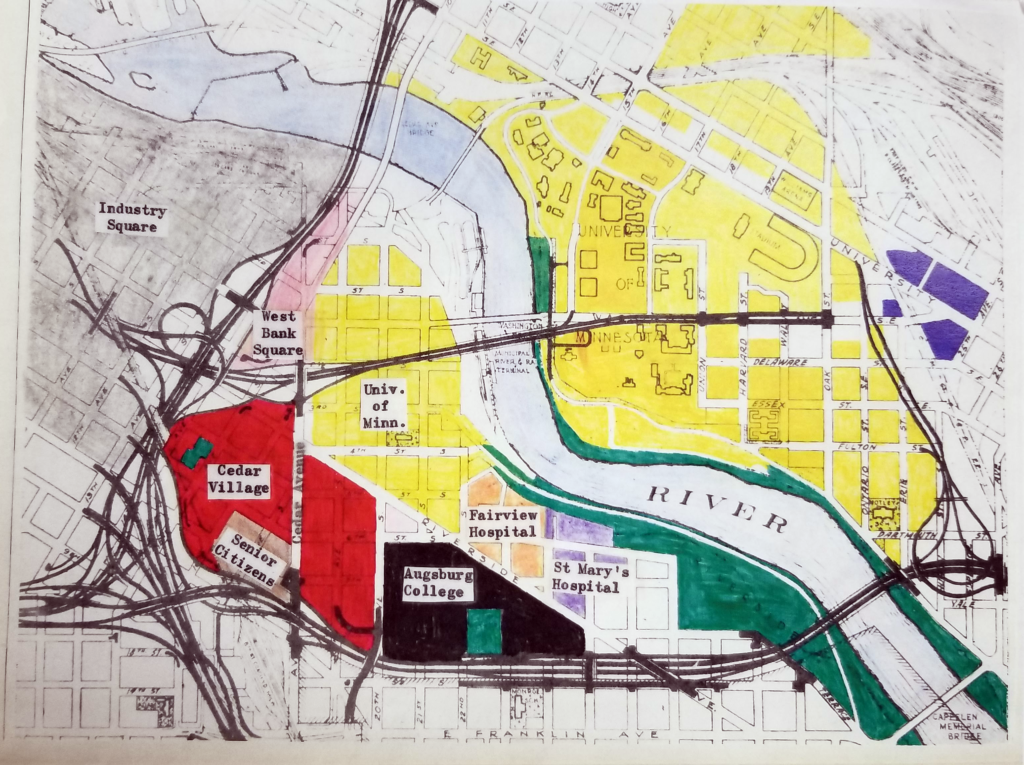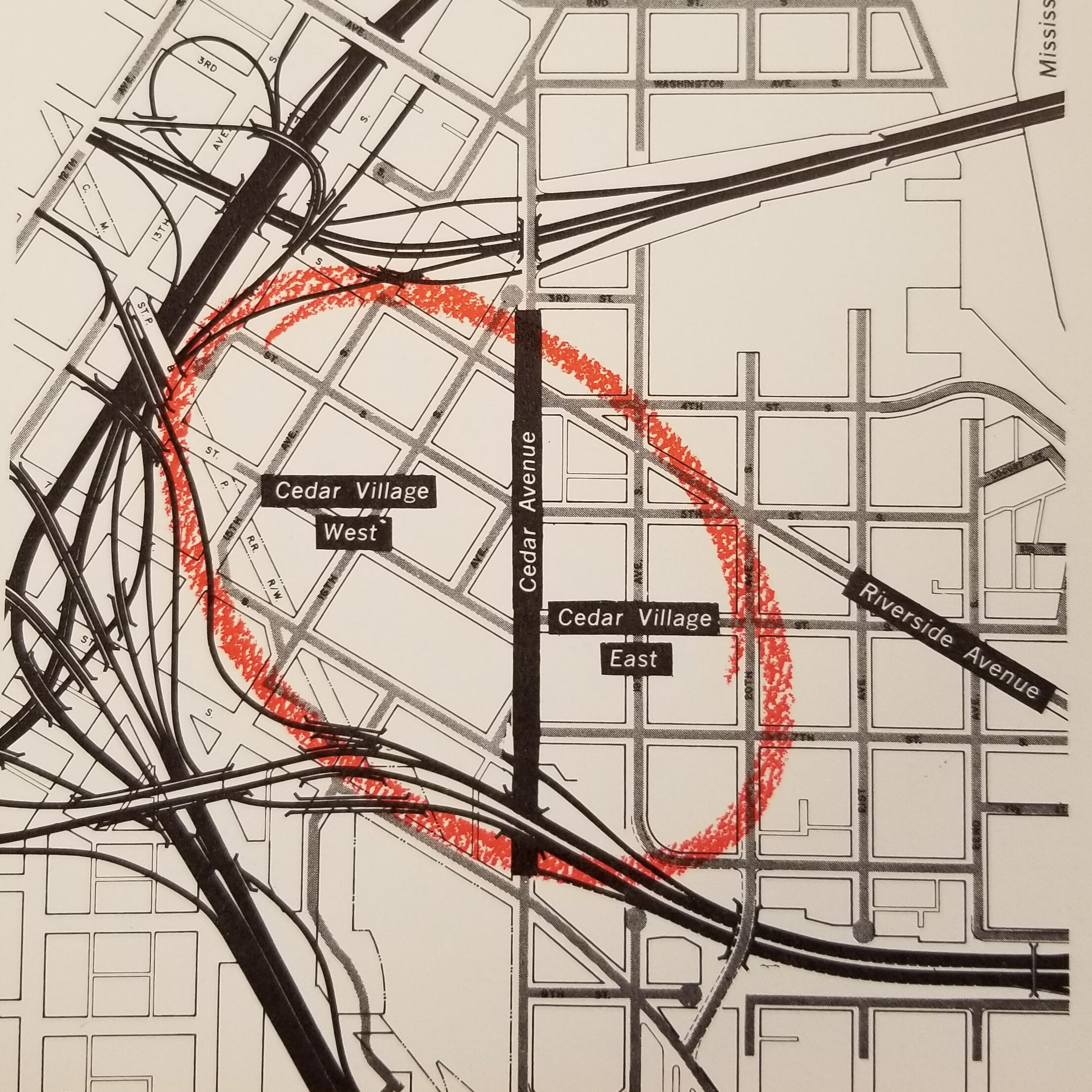The installation of the Interstate Highway System during the Eisenhower Administration caused major changes in urban areas throughout America; changes to our psyche, our lifestyles, and our physical environment.
The massive roadway expansion cemented our love affair with the automobile – increasing our reliance on it for our groceries, our vacations, to travel to our place of work, and our place of worship. City and traffic planners are also continually promoting public transportation, and futurists are even predicting that driverless autos are just around the corner.
The interstate system has facilitated the expansion of the suburbs – enlarging urban areas with white picket fences, manicured front yards, soccer fields, cul-de-sacs, backed up traffic, and greatly extended commuter times.
In many cities, Minneapolis included, the highway expansion has physically split neighborhoods, usually lower economic neighborhoods and ones of color. The highway planners certainly fostered systemic racism into the distant future.
The highway expansion program did contribute to at least one profound positive change in Minneapolis. The University of Minnesota expanded it’s main urban campus across the Mississippi River to the “West Bank” and the Cedar Riverside neighborhood evolved.

The construction of Interstate 35W (going north and south at that location) and the construction of Interstate 94 (going east and west) and the existing Mississippi River, created a large parcel of land surrounded by these three barriers (I-35, I-94, and the river).
The University soon established the boundaries of the West Bank campus. The Augsburg College campus already was located within this newly created area as were the Fairview and St. Mary’s Hospitals. The balance of the newly created neighborhood (approximately equal to that committed to the institutions), was to remain private and continue in its present use or be developed privately.
Cedar Riverside
Historically, the Cedar Riverside area (named after its two principal streets – Cedar Ave. and Riverside Ave.) consisted of small older properties occupied mostly by immigrants. The intersection of Cedar Ave. with Riverside Ave. and the nearby confluence of many streets called Seven Corners served the commercial needs of the area. The entire aging neighborhood had already deteriorated – some vacant lots and even some small industrial properties remained, along with the residential properties..
Two private investment development groups became interested in the ownership and development of projects in the area. The Segal/Heller group selected the area east of Cedar Ave. The leaders of this group were Gloria Segal (a former state representative) and Keith Heller (a rotund instructor at the University of Minnesota).
I was brought in to assist Cedar Riverside Associates, the group interested in the properties west of Cedar Ave.
My job description was short and clear – purchase ALL of the more than 50 properties west of Cedar Ave. and, if successful, manage all of these properties until the time was appropriate to build a low-rise residential series of buildings to serve the adjacent institutions.
Property acquisition began. I negotiated with all 50+ owners, separately, night and day. The acquisition phase lasted almost a year. The Star Tribune called me “the Skulker,” because of my stealthy style. Some of the purchases were certainly noteworthy.
For example –
- The seller of one aging and deteriorated residential property was Arne Carlson – the future Governor of Minnesota.
- Hallie _______ (last name redacted for privacy) owned what appeared to be a large rooming house. Hallie said very directly “you’re not buying real estate – you’re buying a business and I want the proceeds in cash.” Yes, Hallie was a madam running a “house of ill repute.” We bought the property – not the business – and paid in cash. About twenty years later I received a call from Hallie, “I’m going into an assisted living facility and you were so gracious when you purchased my property in Cedar Riverside that I will sell you my duplex/ home adjacent to your Calhoun Square project. I did purchase the duplex for my son and daughter to occupy.
- The purchase of one small property required obtaining 13 signatures of property heirs. I obtained 12 and the thirteenth person was found hanging from a tree in Spirit Lake, Iowa.
- We purchased a tiny abandoned house and found a Tiffany-style lamp in the basement – which turned out to have a value much greater than the purchase price of the house.
- We acquired several businesses that required us to construct a new building and trade it to the property seller.
- There were many more interesting acquisitions; A bookstore, operated by the community, “character”, Melvin McCosh, a dog food manufacturer, several properties owned by real estate speculators and so on etc. etc.
We were successful in acquiring ALL of the properties. Next came the management phase – intended to be only temporary – until the highway construction was completed and the University of Minnesota began to hold classes on the new West Bank campus – perhaps 2-5 years.
The property management phase turned out to be a daily nightmare. A few examples –
- One of the buildings, an up and down duplex had been occupied by a divorced couple living on separate floors. They jointly owned two very large dogs that were never allowed to go outside; the duplex was clearly uninhabitable and was soon demolished.
- An elderly immigrant, Mrs. Ryan, occupied a very small home – living alone – no dogs or cats but only a lifetime collection full of jars of perhaps a million buttons!
- A rooming house – one day a small fire started – fire engines responded rapidly and turned on the water hoses – lots of water. The fire was soon extinguished. Shortly thereafter, the sawdust in the walls (being used as insulation) became soaked with water. The weight of the water soaked sawdust caused the home to collapse.
- A vacant, single floor, house with a full basement. When we went in to prepare to rent it – we found the entire basement filled up to the main level – with rotting trash and garbage.
- When we took over possession of another house, the water bills were astronomically high. We called a plumber who proceeded to look for the problem. Unexpectedly, he fell into a sink hole of water and had to swim to safety.
The Cedar Riverside saga continued. The two private development groups proceeded to begin some joint planning – naming the area Cedar Village. We retained three highly respected, national planning firms (Barton Aschman Assoc., Lawrence Halprin Assoc. and Sasaki Walker) to assist us.
Concurrently, the federal government announced a new funding program which intended to inject innovation, new ideas, and contemporary techniques into urban development. The program was to be called something like “New Towns in Town.” Cedar Village became a candidate for this program. An area near Chanhassen and Chaska, named Jonathan, was also selected as the suburban group to receive funding. The Jonathan portion of the program made some progress and created a somewhat innovative new community.
Cedar Riverside failed miserably. Social engineering became the central theme of the program – assuming that people from totally different backgrounds, different cultures and different income situations could live and thrive in extremely dense vertical living conditions.

Cedar Village was expected to implement this radical concept. The group representing the area east of Cedar Ave (Cedar Village East) was clearly supportive of the In Town Program. At this point, Cedar Village East, with financial support of their principal funder, Henry McKnight, approached the Cedar Village West group and offered to buy all of the Cedar Village West properties with the right of the Cedar Village West partners to reinvest in the larger partnership. The offer was accepted and the sale consummated. The Cedar Village West partners never reinvested.
Then the battles began. Segal and Heller intended to implement the In Town program. Opposition sprouted up from all directions. Tenants and the Tenants Union, led by its brilliant and articulate leader, Jack Caan, were the loudest and most effective. The opposition between the two sides became personal and the media fanned the flames.
Segal and Heller commissioned the well known local architect, Ralph Rapson to design the first phase of Cedar Riverside – which was subsequently built. Trouble continued and success of the In Town program was never fully achieved.
Someone should write the second chapter. George Sherman has assumed control of the properties and is doing a remarkable job –
